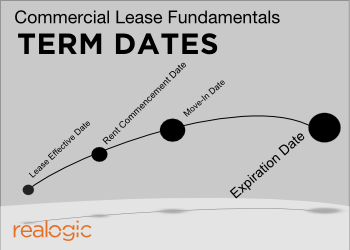
Editor’s Note: We recently updated this post on Term Dates in Commercial Real Estate Leases from 2016, adding new information, expert insights and supporting examples, as well as links to additional resources. To read the updated version of the post on Term Dates, click here.
Last week, we broke down the trickier parts of defining a commercial real estate lease premises over the life of the agreement. Although a lot of that information might seem obvious or commonly available, the most useful part may have been the timeline example of how to visually summarize expanding and contracting suites within a leased premises over the course of multiple lease documents. In this article, we tackle the finer points of understanding a commercial real estate lease term dates.
First, lets start with some definitions:
- Commencement Date
- The date upon which the landlord and the tenant’s rights and obligations under the lease begin. The Commencement Date can be synonymous with Lease Effective Date or the Lease Start Date but is not interchangeable as a rule.
- Rent Commencement Date
- The date upon which the tenant’s responsibility to pay the landlord for use of the space begins. A Rent Commencement Date is very often contingent upon the completion of improvements performed by the landlord and/or the ending of a lease abatement period.
- Move-In Date
- The date upon which a tenant takes physical possession of the Leased Premises for the conduct of its business thereupon. Such date may or may not correspond to the Commencement Date or Rent Commencement Date.
- Full Calendar Months
- As a means of “simplifying” Lease Term expiration dates, most commercial real estate leases employ a method of counting a lease’s duration in Full Calendar Months. This means that a 60 month lease that starts on December 2nd, 2013 ends on December 31st, 2018. This can get especially confusing when the expiration date is calculated on the Lease Effective Date as opposed to the Rent Commencement Date.
- Commencement Letter
- A document that codifies the official beginning of the agreement. These one page letters usually include explicit definitions for all terms but often are not official until executed by both parties.
- Expiration Date
- The date upon which the parties’ rights and obligations under the lease end.
When Term Dates Get Tricky
As you can guess from these definitions, the term of a commercial real estate lease is not always easy to identify. In a perfect scenario, the lease provides a clear commencement date and expiration date. Often times there are “floating” commencement dates or time frames in which the lease will commence rather than an actual firm date. This typically occurs when the parties agree to perform improvements or some construction in the tenant’s space before the tenant may take possession, preventing the parties from pinpointing an exact commencement date. In such a case, the lease may provide that commencement is within 180 days of the Landlord “substantially” completing the work and expires on the last day of the 60th month thereafter.
To understand the lease’s definition of commencement date, expiration date and term, it is imperative to review any possible sections that may impact a commencement date and lease term (such as the Workletter, if work is being performed that will determine a lease commencement date).
I hope that serves as a useful introduction to the mechanics behind commercial real estate lease term dates. This is the final post in the first component section (the Basic Lease Information component) so next week I’ll begin the Rent Component.